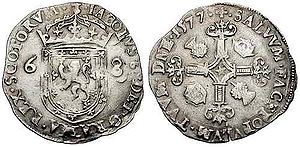Merk (coin)
| James VI: half merk or noble | |
|---|---|
 | |
| Crowned Scottish arms flanked by denomination: 6 and 8 |
Compound cross fleury, quartered with crowns and thistles. |
| 1577 – Silver content 6.57 g (theoretical weight 103.8 grains, equivalent to 6.73 g). Grueber 135 | |
The merk was a Scottish silver coin. Originally the same word as a money mark of silver, the merk was in circulation at the end of the 16th century and in the 17th century. It was originally valued at 13s. 4d. (exactly 2⁄3 of a pound Scots, or about one English shilling), later raised to 14s. Scots.[1] In addition to merks, half-merk (or noble) and quarter-merk coins were produced with values of, respectively, 7s. and 3s. 6d., as well as a four-merk coin of 56s. (£2 16s.).
The first issue weighed 103.8 grains (6.73 g) and was 50% silver and 50% base metals,[2] thus it contained 0.108125 troy ounces (3.3631 g) of silver.
"Markland" or "Merkland" was used to describe an amount of land in Scottish deeds and legal papers. It was based upon a common valuation of the land.
References
^ Marteau, Pierre, English–Scottish currency converter.mw-parser-output cite.citation{font-style:inherit}.mw-parser-output .citation q{quotes:"""""""'""'"}.mw-parser-output .citation .cs1-lock-free a{background:url("//upload.wikimedia.org/wikipedia/commons/thumb/6/65/Lock-green.svg/9px-Lock-green.svg.png")no-repeat;background-position:right .1em center}.mw-parser-output .citation .cs1-lock-limited a,.mw-parser-output .citation .cs1-lock-registration a{background:url("//upload.wikimedia.org/wikipedia/commons/thumb/d/d6/Lock-gray-alt-2.svg/9px-Lock-gray-alt-2.svg.png")no-repeat;background-position:right .1em center}.mw-parser-output .citation .cs1-lock-subscription a{background:url("//upload.wikimedia.org/wikipedia/commons/thumb/a/aa/Lock-red-alt-2.svg/9px-Lock-red-alt-2.svg.png")no-repeat;background-position:right .1em center}.mw-parser-output .cs1-subscription,.mw-parser-output .cs1-registration{color:#555}.mw-parser-output .cs1-subscription span,.mw-parser-output .cs1-registration span{border-bottom:1px dotted;cursor:help}.mw-parser-output .cs1-ws-icon a{background:url("//upload.wikimedia.org/wikipedia/commons/thumb/4/4c/Wikisource-logo.svg/12px-Wikisource-logo.svg.png")no-repeat;background-position:right .1em center}.mw-parser-output code.cs1-code{color:inherit;background:inherit;border:inherit;padding:inherit}.mw-parser-output .cs1-hidden-error{display:none;font-size:100%}.mw-parser-output .cs1-visible-error{font-size:100%}.mw-parser-output .cs1-maint{display:none;color:#33aa33;margin-left:0.3em}.mw-parser-output .cs1-subscription,.mw-parser-output .cs1-registration,.mw-parser-output .cs1-format{font-size:95%}.mw-parser-output .cs1-kern-left,.mw-parser-output .cs1-kern-wl-left{padding-left:0.2em}.mw-parser-output .cs1-kern-right,.mw-parser-output .cs1-kern-wl-right{padding-right:0.2em}.
^ Grueber, Herbert (1970) [1899], Handbook of the Coins of Great Britain and Ireland in the British Museum, London, ISBN 1-4021-1090-1.
This coin-related article is a stub. You can help Wikipedia by expanding it. |
This Scottish history-related article is a stub. You can help Wikipedia by expanding it. |


Comments
Post a Comment